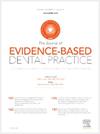EFFICACY OF BIODENTINE VERSUS MINERAL TRIOXIDE AGGREGATE IN PULPOTOMY FOR PRIMARY TEETH: A SYSTEMATIC REVIEW AND META-ANALYSIS OF RANDOMIZED CONTROLLED TRIALS
IF 4
4区 医学
Q1 DENTISTRY, ORAL SURGERY & MEDICINE
引用次数: 0
Abstract
Background
Mineral trioxide aggregate (MTA) and Biodentine, introduced in the 1990s and 2010, are routinely used in primary teeth pulpotomy, yet their relative success remains unclear.
Objectives
This paper aims to compare Biodentine and MTA efficacy in primary teeth pulpotomy over a 6 to 24-month follow-up, assessing clinical, radiographic, and endodontic outcomes.
Materials and Methods
Randomized controlled trials (RCTs) published from March 2010 to March 2025 comparing the efficacy of Biodentine and MTA in primary teeth pulpotomy with ≥6-month follow-up were included. Their efficacy was determined by clinical and radiographic success rates, as well as 2 endodontic outcomes of root resorption and pulp canal obliteration (PCO). A bivariate and random-effect meta-analysis determined the pooled risk ratios (RRs) of the outcomes.
Results
Eleven RCTs comprising 649 patients and 706 primary teeth were included. Clinical success rates were comparable between Biodentine and MTA at 6 months (RR = 1.00; 95% CI: 0.98-1.02), 12 months (RR = 1.01; 95% CI: 0.97-1.04), 18 months (RR = 0.99; 95% CI: 0.95-1.04), and 24 months (RR = 1.00; 95% CI: 0.94-1.07), with no observed heterogeneity (I² = 0%). Radiographic success rates also showed no significant differences at 6 months (RR = 0.99; 95% CI: 0.97-1.02), 12 months (RR = 1.00; 95% CI: 0.96-1.03), 18 months (RR = 1.01; 95% CI: 0.94-1.09), and 24 months (RR = 1.01; 95% CI: 0.94-1.08). Root resorption and pulp canal obliteration occurred at comparable rates across over 6, 12, and ≥18 months of follow-ups.
Conclusion
Biodentine and MTA exerted comparable success rates in primary teeth pulpotomy at follow-ups of up to 2 years.
生物牙牙定与三氧化二矿聚合体在乳牙切髓术中的疗效:随机对照试验的系统回顾和荟萃分析
三氧化矿物骨料(MTA)和生物牙本质分别于20世纪90年代和2010年被引入,通常用于乳牙切髓术,但它们的相对成功尚不清楚。目的通过6 - 24个月的随访,比较生物牙本质汀和MTA在乳牙切髓术中的疗效,评估临床、影像学和牙髓治疗结果。材料与方法纳入2010年3月至2025年3月发表的随机对照试验(rct),比较Biodentine和MTA在乳牙切髓术中的疗效,随访≥6个月。其疗效由临床和影像学成功率以及根吸收和髓管闭塞(PCO)两种根管治疗结果决定。双变量和随机效应荟萃分析确定了结果的综合风险比(rr)。结果共纳入6组随机对照试验,649例患者,706颗乳牙。临床成功率可比Biodentine与MTA在6个月(RR = 1.00;95%可信区间:0.98 - -1.02),12个月(RR = 1.01;95%可信区间:0.97 - -1.04),18个月(RR = 0.99;95%可信区间:0.95 - -1.04),和24个月(RR = 1.00;95%可信区间:0.94 - -1.07),没有观察到的异质性(我² = 0%)。放射成功率在6个月(RR = 0.99;95% CI: 0.97-1.02)、12个月(RR = 1.00;95% CI: 0.96-1.03)、18个月(RR = 1.01;95% CI: 0.94-1.09)和24个月(RR = 1.01;95% CI: 0.94-1.08)时也无显著差异。在6个月、12个月和≥18个月的随访中,根吸收和髓管闭塞的发生率相当。结论生物牙定和MTA治疗乳牙切髓术后随访2年,成功率相当。
本文章由计算机程序翻译,如有差异,请以英文原文为准。
求助全文
约1分钟内获得全文
求助全文
来源期刊

Journal of Evidence-Based Dental Practice
DENTISTRY, ORAL SURGERY & MEDICINE-
CiteScore
6.00
自引率
16.70%
发文量
105
审稿时长
28 days
期刊介绍:
The Journal of Evidence-Based Dental Practice presents timely original articles, as well as reviews of articles on the results and outcomes of clinical procedures and treatment. The Journal advocates the use or rejection of a procedure based on solid, clinical evidence found in literature. The Journal''s dynamic operating principles are explicitness in process and objectives, publication of the highest-quality reviews and original articles, and an emphasis on objectivity.
 求助内容:
求助内容: 应助结果提醒方式:
应助结果提醒方式:


